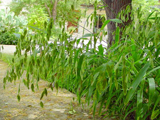Native Plants

Q. Who is Mr. Smarty Plants?
A: There are those who suspect Wildflower Center volunteers are the culpable and capable culprits. Yet, others think staff members play some, albeit small, role. You can torture us with your plant questions, but we will never reveal the Green Guru's secret identity.
Did you know you can access the Native Plant Information Network with your web-enabled smartphone?
Ask Mr. Smarty Plants is a free service provided by the staff and volunteers at the Lady Bird Johnson Wildflower Center.

rate this answer
Tuesday - October 26, 2010
From: North Augusta , SC
Region: Southeast
Topic: Erosion Control
Title: Plants for erosion control along creek in South Carolina
Answered by: Nan Hampton
QUESTION:
We have a creek that runs thru our property and it is eroding our rip rap. The creek runs head on into an embankment which is causing the worse issue. Is there anything we can plant to help stop the erosion. We live on the Savannah River.ANSWER:
I will suggest some plants that could help, but you may need to use additional measures to keep your streambank from eroding. There are various biotechnical methods to stabilize streambanks and you can read about them in this excellent article from the USDA National Agroforestry Center, Biotechnical Streambank Protection: The use of plants to stabilize streambanks (Agroforestry Note #23, March 2002). The article describes various streambank erosion problems and suggested solutions. For slopes that are normally above the creek level grasses are very effective. They have fibrous roots systems that are very good at holding the soil in place. If you are experiencing a significant amount of runoff down the slope, you might want to consider laying down erosion control blankets (available at most plant nurseries) before spreading grass seeds. Nearer to stream level you will want to have plants such as willows that can tolerate growing in very wet soils or even immerged in the water for periods of time.
Here are some suggestions for grasses that do well in moist areas that you could plant on the slope above the stream. Some of these will also grow near the stream edge. There are suggestions for woody plants that will grow well closer to the creek edge. Since I don't know the situation at your site for available sunlight and type of soil, you will need to check carefully the GROWING CONDITIONS on each of the species pages to be certain that they are compatible with your site.
Andropogon glomeratus (Bushy bluestem) grows well in wet areas and prefers full sun.
Andropogon virginicus (Broomsedge bluestem) is recommended for erosion control and grows in part shade.
Carex blanda (Eastern woodland sedge) grows in moist soils in sun, part shade or shade.
Carex cherokeensis (Cherokee sedge) grows in moist soils in part shade.
Chasmanthium latifolium (Inland sea oats) prefers shade or part shade and moist soils.
Cladium mariscus ssp. jamaicense (Jamaica swamp sawgrass) grows at the edges of streams in sun and part shade.
Panicum virgatum (Switchgrass) grows along streambanks in sun or part shade.
Tripsacum dactyloides (Eastern gamagrass) likes part shade and grows in moist areas or along streambanks.
Cephalanthus occidentalis (Common buttonbush) grows in moist areas and will grow in standing water in shade or part shade.
Salix humilis (Prairie willow) grows in sun along streambanks.
Salix nigra (Black willow) grows in sun, part shade and shade along streambanks.
Sambucus nigra ssp. canadensis (Common elderberry) grows in part shade and is good for erosion control in moist areas.
Forestiera acuminata (Eastern swamp-privet) will grow in moist soil or standing water in part shade.
Alnus serrulata (Hazel alder) grows in sun, part shade and shade on stream banks and other wet areas.
Here are photos from our Image Gallery:
More Erosion Control Questions
Removing Texas cedar Juniperus ashei from Blanco River banks
February 26, 2014 - Dear Mr. Smarty Plants,
Should cedar trees be removed from our Blanco River banks to prevent them from sucking too much of our precious water before it makes it into the river system?
If so, what s...
view the full question and answer
Grass for erosion control
July 19, 2008 - I have a very shaded sloped back yard. I have not been able to get grass to grow due to the shade. There are approximately twenty 30-40 ft. Oaks in the yard. The yard slopes toward the house. I wo...
view the full question and answer
Native plants for erosion control in South Dakota
December 04, 2008 - Dear Mr. Smarty Plants: I live in the Black Hills of South Dakota at about 5000 feet ASL. My house is on a steep hill. I had to clear a perimeter around my house of all the pine trees for fire supp...
view the full question and answer
Erosion Control with perennials for a shady Dallas bank
July 25, 2013 - Thank you for your help with turf or perennials on a shaded bank, 4000 sq ft, for the Dallas area that has good roots, grows in semi shade to shade, is on a steep bank so cannot mow, and flowers the l...
view the full question and answer
Plants to grow in sandy shade with steep slope
August 14, 2014 - I'm a very experienced gardener but I'm completely stumped on this one.
We live among the dunes in SW Michigan. Our yard mostly consists of Ammophila breviligulata and Asclepias syriaca bisec...
view the full question and answer
| Support the Wildflower Center by Donating Online or Becoming a Member today. |

